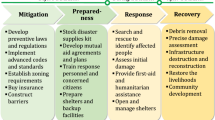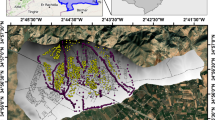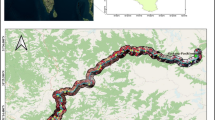Abstract
Earthquake is a natural disaster which causes extensive damage as well as the death of thousands of people. Earthquake professionals for many decades have recognized the benefits to society from reliable earthquake predictions. Techniques like: mathematical modelling, hydrology analysis, ionosphere analysis and even animal responses have been used to forecast a quake. Most of these techniques rely on certain precursors like, stress or seismic activity. Data mining techniques can also be used for prediction of this natural hazard. Data mining consists of evolving set of techniques such as association rule mining that can be used to extract valuable information and knowledge from massive volumes of data. The aim of this study is to predict a subsequent earthquake from the data of the previous earthquake. This is achieved by applying association rule mining on earthquake data from 1979 to 2012. These associations are polished using predicate-logic techniques to draw stimulating production-rules to be used with a rule-based expert system. Prediction process is done by an expert system, which takes only current earthquake attributes to predict a subsequent earthquake. The rules generated for predicting the earthquake are mathematically validated as well as tested on real life earthquake data. Results from our study show that the proposed rule-based expert system is able to detect 100 % of earthquakes which actually occurred within 15 hours at-most within a defined range, depth and location. This work solely relies on previous earthquake data for predicting the next.










Similar content being viewed by others
References
Agrawal, R., & Bayardo, R.J. Jr (1999). Mining the most interesting rules. In Proceedings of the 1999 ACM SIGKDD international conference on knowledge discovery and data mining - SIGKDD ’99 (pp. 145–154).
Allen, C.R., Edwards, W., Hall, W.J., Knopoff, L., Raleigh, C.B., Savit, C.H., Toksoz, M.N., Turner, R.H. (1976). Predicting earthquakes: a scientific and technical evaluation—with implications for society. Panel on Earthquake Prediction of the Committee on Seismology, Assembly of Mathematical and Physical Sciences, National Research Council, US National Academy of Sciences. Washington.
Alvan, H.V., & Azad, F.H (2011a). Satellite remote sensing in earthquake prediction. A review. doi:10.1109/NatPC.2011.6136371.
Alvan, H.V., & Azad, F.H. (2011b). Satellite remote sensing in earthquake prediction. A review, National Postgraduate Conference (NPC), Publication Year (pp. 1–5).
Aminzadeh, F., Katz, S., Aki, K (1994). Adaptive neural nets for generation of artificial earthquake precursors. IEEE transactions on geoscience and remote sensing (Vol. 32, no. 6).
ANSS Catalog Search (2013). http://www.ncedc.org/anss/catalog-search.html. Accessed Mar 2013.
Dehbozorgi, L., & Farokhi, F. (2010a). Effective feature selection for short-term earthquake prediction using Neuro-Fuzzy classifier. Centran TehranBranch. Sci. Assoc. of Electr. & Electron. Eng., Islamic Azad University. Tehran.
Dehbozorgi, L., & Farokhi, F. (2010b). Effective feature selection for short-term earthquake prediction using Neuro-Fuzzy classifier. In 2010 2nd IITA international conference on geoscience and remote sensing (IITA-GRS), (Vol. 2, Publication Year 2010, pp. 165–169).
de Souza, F.T., & Wang, Z. (2010). A Data Mining approach to predict mass movements induced by seismic events in Sichuan, China. In 2010 6th international conference on natural computation (ICNC), (Vol. 3, Publication Year 2010, pp. 1172–1177).
Gokhberg, M.B., Morgounov, V.A., Pokhotelov, O.A. (1995). Earthquake prediction, seismo-electromagnetic phenomena. Amsterdam: Gordon and Breach Science Publishers.
Han, J., & Pei, J. (2004). Mining frequent patterns without candidate generation: a frequent-pattern tree approach. Data Mining and Knowledge Discovery, 8, 53–87.
Hanna, A.M., Ural, D., Saygili, G. (2007). Neural network model for liquefaction potential in soil deposits using Turkey and Taiwan earthquake data. Soil Dynamics and Earthquake Engineering, 27(6).
John, B., Rundle, D.L., Turcotte, W.K. (2000). Geocomplexity and the physics of earthquakes (Geophysical Monograph Series), 1st edn. Wiley-AGU; .
Jusoh, M.H., Ya’acob, N., Saad, H., Sulaiman, A.A., Baba, N.H., Awang, R.A., et al. (2008). Earthquake prediction technique based on GPS dual frequency system in equatorial region. IEEE International RF and Microwave Conference Proceedings, 372–376. doi:10.1109/RFM.2008.4897373.
Kossobokov, V.G., & Soloviev, A.A. (2008). Prediction of extreme events: fundamentals and prerequisites of verification. Russian Journal of Earth Sciences.
Li, X. (2011). An intelligent system for earthquake early warning intelligent systems and applications (ISA). In 2011 3rd international workshop on digital object identifier (Publication Year 2011, pp. 1–4).
Liao, S-H. (2005). Expert system methodologies and applications—a decade review from 1995 to 2004. Expert Systems with Applications, 28(1), 93–103.
Liu, J.Y., Chen, Y.I., Chuo, Y.J., Tsai, H.F (2001). Variations of ionospheric total content during the Chi-Chi earthquake. Geophysical Research Letters, 28, 1381–1386.
Liu, S., Yang, D., Ma, B., Wu, L, Li, J., Dong, Y. (2007). On the features and mechanism of satellite infrared anomaly before earthquakes in Taiwan Region. In IEEE international geoscience and remote sensing symposium, 2007. IGARSS 2007 (Publication Year 2007, pp. 3719–3722).
Mouri, M., Funase, A., Takumi, I., Cichocki, A., Yasukawa, H., Hata, M. (2008). Effectiveness of global signal elimination from environmental electromagnetic signals for earthquake prediction. In Information theory and its applications, 2008. ISITA 2008. International symposium on publication year 2008 (pp. 1–6).
Nimmagadda, S.L., & Dreher, H. (2007a). Ontology based data warehouse modeling and mining of earthquake data: prediction analysis along Eurasian-Australian continental plates. In 2007 5th IEEE international conference on industrial informatics (Vol. 1, pp. 597–602).
Nimmagadda, S.L., & Dreher, H. (2007b). Ontology based data warehouse modeling and mining of earthquake data: prediction analysis along Eurasian-Australian continental plates. In 2007 5th IEEE international conference on industrial informatics (Vol. 1, Publication Year 2007, pp. 597–602).
Otari, G.V., & et al (2012). A review of application of data mining in earthquake prediction. International Journal of Computer Science and Information Technologies, 3(2).
Parker, B. (2010). The power of the sea: tsunamis, storm surges, rogue waves, and our quest to predict disasters (pp. 7–30). Palgrave Macmillan.
Pulinets, S. (2004). Ionospheric precursors of earthquakes; Recent advances in theory and practical applications. TAO, 15(3), 413–435.
Qiang, Z., Zeng, Z., Wang, J., Ma, A., Hongjie, X. (2009). Study on short-term and imminent earthquake prediction using the satellite thermal infrared technique. In 4th international conference on cooperation and promotion of information resources in science and technology, 2009. COINFO ’09 (Publication Year 2009, pp. 372–381).
Sikder, I.U., & Munakata, T. (2009). Application of rough set and decision tree for characterization of premonitory factors of low seismic activity. Expert Systems with Applications, 36(1).
Tsunekawa, H. (1998). A fuzzy neural network prediction model of the principal motions of earthquakes based on preliminary tremors. In Proceedings of the 24th annual conference of the IEEE industrial electronics society, 1998. IECON ’98 (Vol. 1, Publication Year 1998, pp. 46–51).
USGS (2013). Earthquake hazards program. http://earthquake.usgs.gov/. Accessed Mar 2013.
Wei, X., Cui, X., Jiang, C., Zhou, X (2009). The earthquake probability prediction based on weighted factor coefficients of principal components. IEEE. doi:10.1109/ICNC.2009.438.
Wu, S., Fang, M., Li, Y., Zhang, B. (2008). An earthquake sequential pattern mining algorithm based on general constraint young computer scientists. In The 9th international conference 2008. ICYCS 2008 (Publication Year 2008, pp. 1878–1883).
Wu, L., Qin, K., Liu, S. (2012). GEOSS-based thermal parameters analysis for earthquake anomaly recognition. Proceedings of the IEEE, 100(10), 2891–2907.
Xing, Z., Pei, J., Dong, G., Yu, P.S (2008). Mining sequence classifiers for early prediction.
Author information
Authors and Affiliations
Corresponding author
Appendices
Appendix A
Appendix B
1.1 Domain knowledge
Domain knowledge referred here signifies the expertise specific to a ‘field of study’, earth and geo-sciences in our case. Domain Knowledge (DK) is a transition from ‘pure mathematics’ to ‘applied mathematics’ and in our case it works like this:
If a phrase is let: Medium Quake OR High Quake
then through Domain Knowledge it can be inferred that
the phrase actually mean: NOT Low Quake
This manipulation is domain specific and does not apply to general variables. Same statement using general variables P, Q and R can not proceed the same way
Let: P OR Q can not deduce: NOT R.
Unless P =medium-quake, Q =high-quake and R =low-quake (constants).
Rights and permissions
About this article
Cite this article
Ikram, A., Qamar, U. A rule-based expert system for earthquake prediction. J Intell Inf Syst 43, 205–230 (2014). https://doi.org/10.1007/s10844-014-0316-5
Received:
Revised:
Accepted:
Published:
Issue Date:
DOI: https://doi.org/10.1007/s10844-014-0316-5




